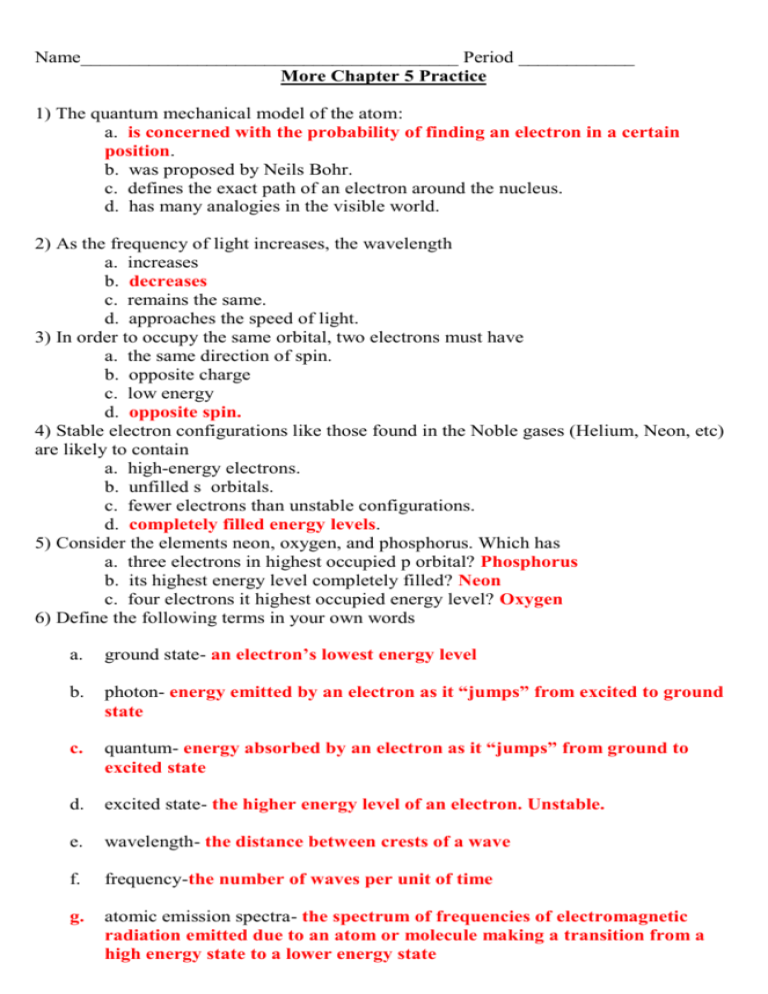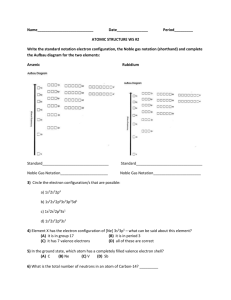Name_______________________________________ Period
advertisement

Name_______________________________________ Period ____________ More Chapter 5 Practice 1) The quantum mechanical model of the atom: a. is concerned with the probability of finding an electron in a certain position. b. was proposed by Neils Bohr. c. defines the exact path of an electron around the nucleus. d. has many analogies in the visible world. 2) As the frequency of light increases, the wavelength a. increases b. decreases c. remains the same. d. approaches the speed of light. 3) In order to occupy the same orbital, two electrons must have a. the same direction of spin. b. opposite charge c. low energy d. opposite spin. 4) Stable electron configurations like those found in the Noble gases (Helium, Neon, etc) are likely to contain a. high-energy electrons. b. unfilled s orbitals. c. fewer electrons than unstable configurations. d. completely filled energy levels. 5) Consider the elements neon, oxygen, and phosphorus. Which has a. three electrons in highest occupied p orbital? Phosphorus b. its highest energy level completely filled? Neon c. four electrons it highest occupied energy level? Oxygen 6) Define the following terms in your own words a. ground state- an electron’s lowest energy level b. photon- energy emitted by an electron as it “jumps” from excited to ground state c. quantum- energy absorbed by an electron as it “jumps” from ground to excited state d. excited state- the higher energy level of an electron. Unstable. e. wavelength- the distance between crests of a wave f. frequency-the number of waves per unit of time g. atomic emission spectra- the spectrum of frequencies of electromagnetic radiation emitted due to an atom or molecule making a transition from a high energy state to a lower energy state 7) True or False (if false, correct the statement to make it true): The position and velocity of an electron in an atom can be determined with great certainty. False--- quantum mechanics and Heisenberg Uncertain Principal illustrate electron energy levels provide a probability of finding electrons in their orbitals 8) True or False (if false, correct the statement to make it true): Electrons moving from one energy level to a higher energy level another emit photons. False—electrons moving from higher to lower energy levels emit photons 9) Write a complete electron configuration of each atom. a. hydrogen --- 1s1 b. magnesium --- 1s2 2s2 2p6 3s2 c. sulfur --- 1s2 2s2 2p6 3s2 3p4 d. beryllium- 1s2 2s2 10) Arrange the colors in order from highest energy (7) to the lowest energy (1) Orange 2 Green 4 Violet 7 Indigo 6 Red 1 Yellow 3 Blue 5 11) Complete the table about atomic models and the scientist who developed them Scientist Dalton Model of the Atom Atoms are tiny indestructible particles Thompson Cathode Ray experiment. Discovers electrons. “Plum Pudding” model of atom Rutherford Gold foil experiment. Dense center (nucleus) but atom is mostly empty space. Bohr Electrons move in orbitals. Quantum of energy “excites” electrons into higher energy levels. Schrödinger Quantum mechanical model of atom. More clearly defined energy levels of electrons









